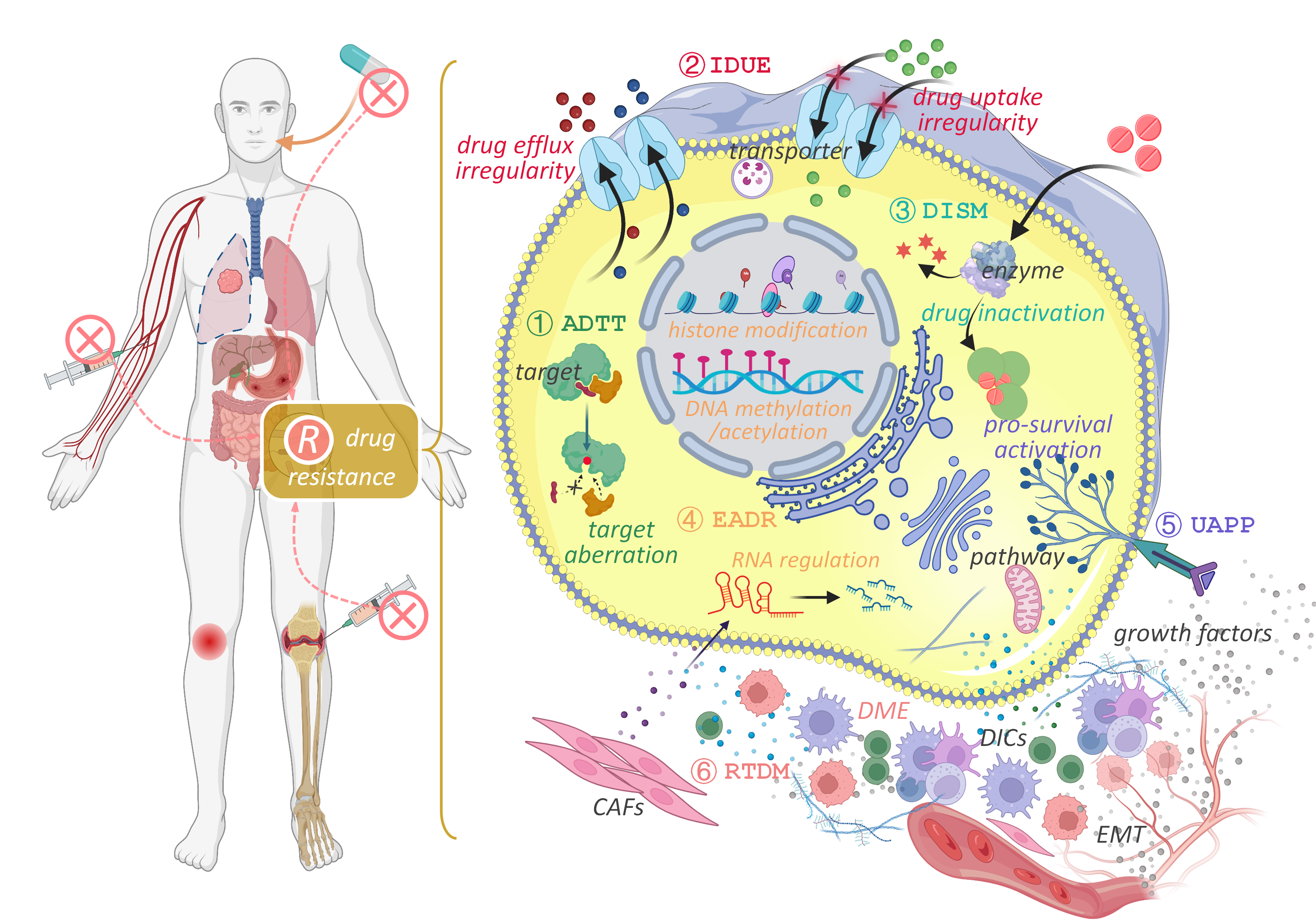DRESIS is a comprehensive database for drug resistance information. It was introduced to (a) systematically provide, for the first time, all existing types of molecular mechanism underlying drug resistance, (b) extensively cover the widest range of diseases among all existing databases, and (c) explicitly describe the clinically/experimentally verified resistance data for the largest number of drugs. Particularly, a comprehensive literature review was first conducted by searching PubMed, which led to over 20,000 drugs with clinically/experimentally validated resistance information. Second, 395 resistance diseases corresponding to these drugs were manually retrieved from the literatures, which, to the best of our knowledge, covered much wider range of disease classes compared to other available databases. Finally, for all collected drugs, the molecular mechanisms with a total of 2,197 key resistance molecules underlying resistance were systematically collected, and the disease- and tissue-specific abundance of the resistance-relevant molecules were analyzed and provided in the DRESIS database.


ADTT : Aberration of the Drug's Therapeutic Target
Aberration of the drug’s therapeutic target leads to drug resistance primarily through steric impact on drug binding, impact on cofactor affinity or conformational change of target, which is one of the most common mechanisms (Chem Rev. 121: 3297-3351, 2021).
For example, the T790M gatekeeper mutation in EGFR significantly renders resistance of EGFR inhibitor gefitinib in lung cancer, the reason of which is that T790M in EGFR increases the affinity of the kinase toward adenosine triphosphate (Clin Cancer Res. 12: 6494-6501, 2006; Proc Natl Acad Sci USA. 105: 2070-2075, 2008).
IDUE : Irregularity in Drug Uptake and Drug Efflux
Irregularity in drug uptake and drug efflux for drug resistance mainly includes the increased drug efflux, decreased drug uptake. Such mechanism can reduce the concentration of the drug in the cellular environment, which in turn limits the drug efficacy against a target disease and therefor leads to drug resistance (Chem Rev. 121: 3297-3351, 2021).
For example, the ATP-binding cassette (ABC) transporter P-glycoprotein (MDR1), acting as the cell membrane pump, are capable of removing the drugs from cancer cells. Therefore, the increased expression of MDR1 plays an important role in multidrug resistance in various diseases, such as gastric cancer, hepatocellular carcinoma, chronic myeloid leukemia, rheumatoid arthritis and so on (J Natl Cancer Inst. 107: djv222, 2015; Oncol Rep. 37:2193-2200, 2017)
DISM : Drug Inactivation by Structure Modification
Drug inactivation by structure modification for drug resistance mainly influences the intracellular active drug concentrations via the mutation or abnormal expression of various drug-metabolizing enzyme (Drug Resist Updat. 52: 100703, 2020).
For example, one of the reasons for cisplatin resistance in lung cancer is due to the increased glutathione expression, which promotes inactivation of cisplatin (Mol Med Rep. 11: 682-690, 2015; Chem Rev. 121: 3297-3351, 2021).
EADR : Epigenetic Alteration of DNA, RNA or Protein
Epigenetic alteration, such as DNA methylation patterns, histone modification patterns, Protein translational modification patterns, non-coding RNAs regulations patterns and so on, can influence disease development and lead to drug resistance
For example, the H3K27 methyltransferase, enhancer of zeste homolog 2 (EZH2), contributes to acquired cisplatin resistance through epigenetic gene silencing and chromatin remodeling in ovarian cancer (Cancer Biol Ther. 10: 788-795, 2021; Oncogene. 38: 564-580, 2019).
UAPP : Unusual Activation of Pro-survival Pathway
Unusual activation of multiple Pro-survival signaling pathways confers survival advantages upon disease cells and contributes to drug resistance through dysregulation of key cellular activities such as proliferation, differentiation, autophagy or apoptosis (Drug Resist Updat. 52: 100703, 2020).
For example, the trastuzumab resistance in breast cancer can results from the hyperactive activation of PI3K-AKT-mTOR interconnected pathways mediated by the loss of PTEN or PIK3CA mutation which also takes part in the coupling of growth factor signaling with gene regulation to modulate cell processes such as activating proliferation and downregulating apoptosis pathways (Clin Cancer Res. 18: 6784-6791, 2012; Curr Med Chem. 20: 1923-1945, 2013)
RTDM : Regulation by the Disease Microenvironment
Disease microenvironment regulation, especially tumor microenvironment, which contains the surrounding space composed of immune cells, stroma and vasculature multiple cell types, can mediate resistance by several mechanisms such as preventing immune clearance of tumor cells, hindering drug absorption and stimulating paracrine growth factors to signal cancer cell growth (Nature. 575: 299-309, 2019).
For example, doxorubicin resistance in breast cancer is via the mechanism of cell-to-cell communication miR-155 exosome-mediated resistance transmission. Particularly, breast cancer cells overexpressing miR-155 acquired epithelial-to-mesenchymal transition properties, promoted higher migration rate, and were able to form more mammospheres, which associates with miR-155 regulating certain genes related to breast cancer stem cells that are resistant to therapy (J Natl Cancer Inst. 13: 107, 2015; Sci Rep. 8: 829, 2018).

